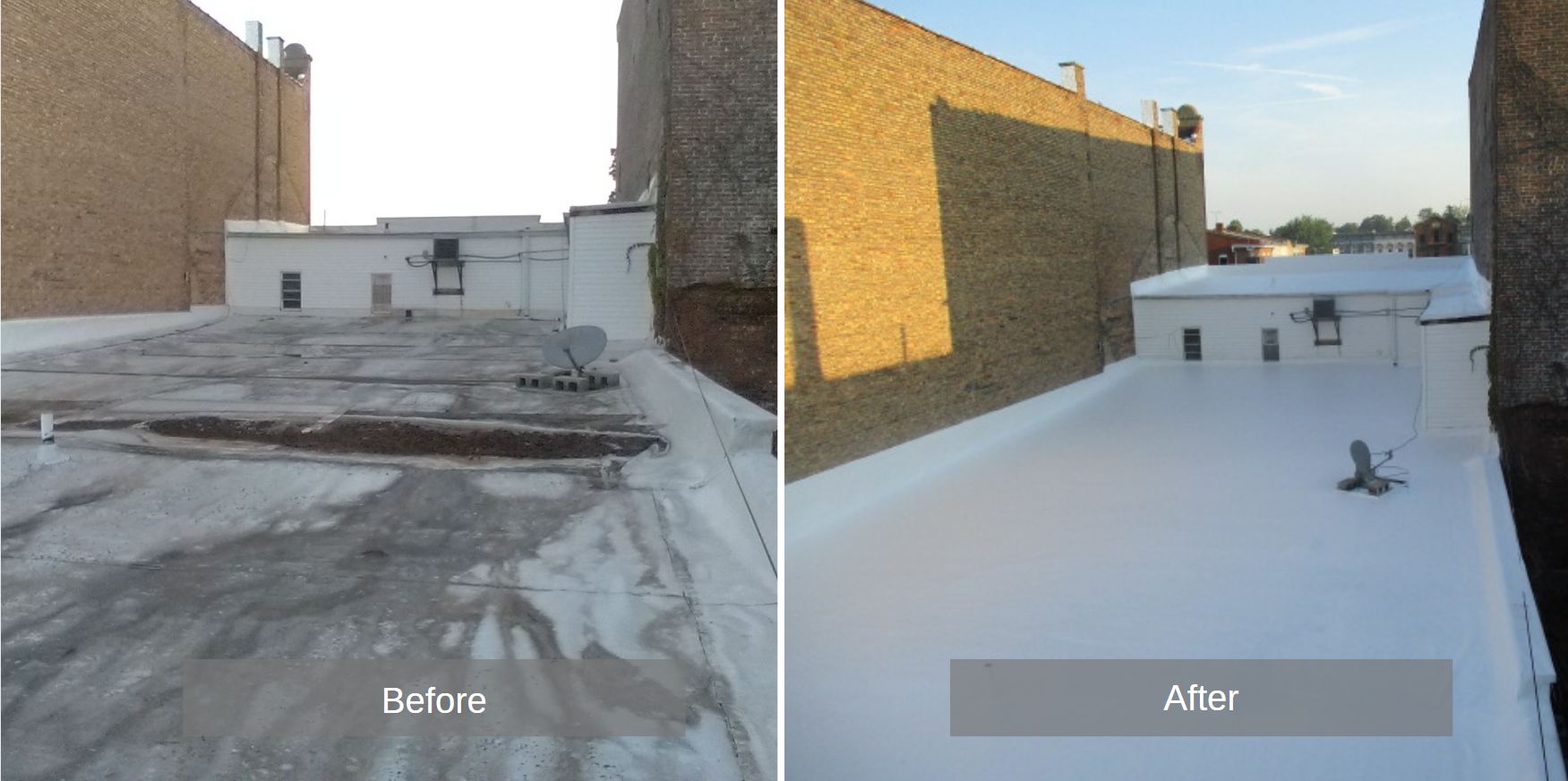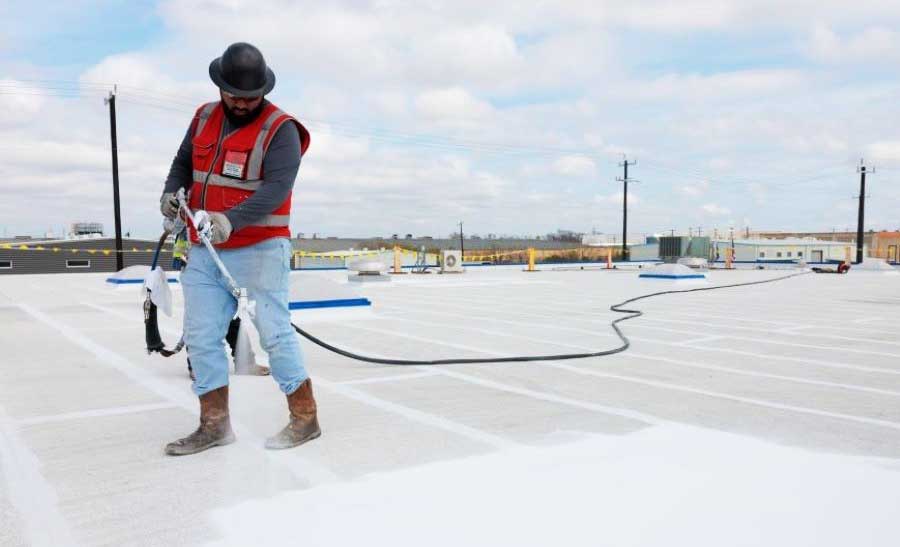Navigating the wide variety of roof coatings on the market can be a daunting task for facility managers and building owners. Understanding the differences and benefits of each type is crucial in making the right decision for your specific needs. Our guide, "A Guide to the 4 Most Common Roof Coatings: Choosing the Perfect One for Your Building," is designed to simplify this process. We delve into the characteristics, applications, and advantages of the four most common roof coatings, providing you with the necessary knowledge to choose the perfect solution for your building's protection, durability, and cost-effectiveness. Let's embark on this journey together to ensure your building's roof is equipped with the best.
1. Silicone Coatings
Gaco's silicone coatings are among the top choices in the roofing industry. They are manufactured with a high solids’ dispersion of 100% silicone, creating an elastomeric coating that provides excellent adhesion to the existing roof surface.
Silicone is a highly elastic material, providing flexibility without sacrificing its adherence. This makes it a highly reliable option for roofs that experience shifting or movement. Silicone coatings are exceptionally weather-resistant and remain flexible without hardening or becoming brittle over time, a feature that has helped them gain a significant market share in the past decade.
The ability of Gaco's silicone coatings to withstand long-term exposure to ponding water sets them apart. Most other roof coatings fail in these conditions, but silicone maintains its integrity, providing a long-lasting solution for low-lying areas of a roof that collect water.
Additionally, silicone coatings offer superior ultraviolet protection, which is crucial in extreme temperatures and harsh environments. They also resist oxidation, maintaining their original condition for a longer period.
Although silicone coatings are a bit costlier than other options, their resilience and low maintenance often make them a cost-effective solution in the long term. Moreover, with Gaco's range of silicone products, you can choose from a variety of colors to match the aesthetics of your building, without sacrificing the high reflectivity and emissivity ratings.
Silicone coatings do have a few drawbacks, including the fact that there are only a few materials, other than silicone, that can be applied directly to the silicone surface. Also, silicone tends to hold dirt on the surface, which can reduce its reflectivity over time. However, with regular maintenance, these issues can be minimized.

2. Acrylic Coatings
Acrylic coatings are a popular choice in the roofing industry, initially designed to provide ultraviolet protection for sprayed urethane foam applications. Gaco, a leading name in the roofing industry, is a manufacturer of such products. These coatings are used on various roof membrane surfaces, including single-ply membranes and metal systems, due to their versatility and protective qualities.
Formulated from 100% acrylic, they are known for their excellent resistance to radiation and hail damage, which significantly improves the durability of your roofing system. The inherent flexibility of acrylic-based materials allows them to withstand the dimensional instability of most roof membrane surfaces, adapting to the changing conditions without cracking or peeling.
Research indicates that properly formulated acrylic coatings can reduce surface temperature by as much as 20 degrees Fahrenheit when exposed to direct sunlight at 85 degrees Fahrenheit. This temperature-lowering capability contributes to a cooler interior environment, which can lead to substantial energy savings.
Acrylic coatings can be applied in one or more coats depending on the coverage requirements. Most manufacturers, including Gaco, provide warranties based on the coverage rates. Acquiring extended warranties may require additional coverage.
However, there are certain environmental considerations to bear in mind when applying acrylic coatings. They should not be applied in freezing temperatures or when precipitation may occur within a specified period from application. The cure time of these products is highly dependent on weather conditions, and cold weather or high humidity can impede the curing process. Ideal curing conditions involve warm weather and low humidity.
Despite these considerations, acrylic coatings remain a popular choice because they are economical, provide excellent reflectivity, and are easy to work with. Yet, they do lose mil-thickness from weathering, require application in an ambient temperature of above 50 degrees Fahrenheit, and cannot withstand ponding water. Gaco, however, has overcome some of these challenges by offering instant-set materials that reduce the cure time to a few minutes, practically eliminating the risk of coating run-off if precipitation occurs shortly after application.

3. Polyurethane Coatings
Polyurethane coatings have been a game-changer in the roofing industry, initially developed to be applied over sprayed-in-place foam roofs. Today, they're used as coating applications over a variety of existing roof membranes, thanks to their robustness and adaptability.
Gaco's polyurethane coatings offer the best resistance rates of all coatings for impact and foot traffic. If you have a roof that sees a lot of activity, a polyurethane coating can provide the durability you need.
Polyurethane roof coatings are divided into two types: aromatic (base coat) and aliphatic (topcoat). The aromatic base coat material is durable but does not offer high UV resistance, while the aliphatic topcoat is UV stable, stays clean, and retains its color longer than other coatings. When applied in combination, they offer an exceptional balance of durability, UV resistance, and aesthetic appeal.

4. Elastomeric Asphaltic Rubber Membrane Systems
In response to the need for innovative roofing solutions, Gaco has developed elastomeric asphaltic rubber membrane systems. This modern, fluid-applied system combines the elastic properties of rubber with the waterproofing and weatherproofing characteristics of emulsified asphalt to form a seamless membrane that instantly waterproofs the surface it's applied to.
This type of roofing solution can be a game-changer for extending the service life of your existing roof system. It forms a monolithic, seamless membrane that adheres to the roof's surface, providing superior waterproofing capabilities compared to other solutions that only provide a film surface or require reinforcements for waterproofing capacity.
In conclusion, at GoTech Roofing, we believe that understanding the different types of roof coatings and their suitability for your specific project is essential. We work closely with industry leaders like Gaco to provide the best possible roofing solutions for our clients. Whether you're considering a cost-saving, long-lasting elastomeric asphaltic rubber membrane system, or need guidance on a silicone spraying job, our team is ready to assist. Contact us today for a comprehensive consultation.
Click here to read more about GoTech Roofing's Roof Coatings in detail: Elastomeric Roof Coatings
” With our GoTech Proprietary Customer Service-Oriented Roofing Process you can skip the headaches, schedule delays, lack of contractor communication, cost increases, and nonsense – we handle every roofing project detail from start to finish in a digitally written scheduled process you will receive on day one ”
Julian Stevens
Trust GoTech Roofing in Northern Virginia and Washington DC
Founded by Julian Stevens over a decade ago, GoTech Roofing has established itself as the number 1 provider of roofing services in Northern Virginia and Washington DC. We provide roof repair and roof replacement services with a real focus on customer satisfaction. We are a Class A Contractor and fully insured with Workman's Compensation and Liability Insurance. GoTech Roofing provides each and every client with an incomparable roofing experience through our outstanding customer service and exceptional quality. We understand that each roof is unique and will treat it as such. Having worked 10 years providing multi-million dollar contracting services for the Federal Government, Julian took a look at the antiquated roofing construction process and knew there was a better way. He built GoTech Roofing utilizing Dynamics Customer Relationship Management (CRM) software fully integrated with Microsoft Project Professional software to create a Proprietary Customer Service-Oriented Roofing Process that starts with your first communication with us all the way to when we shake hands when the job is done. With our GoTech Proprietary Customer Service-Oriented Roofing Process you can skip the headaches, schedule delays, lack of contractor communication, cost increases, and nonsense – we handle every roofing project detail from start to finish in a written scheduled process you will receive on day one.